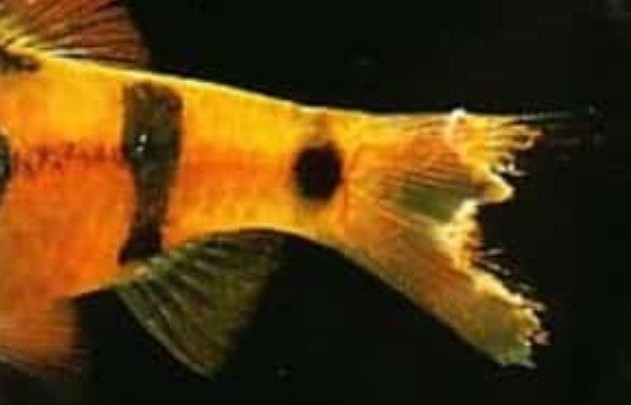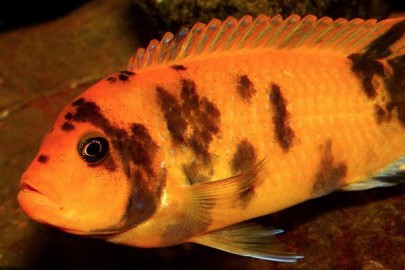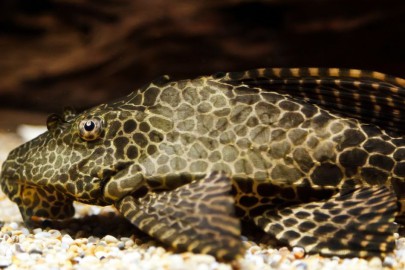Discus Fin Rot – How to Treat and Prevent It
Discus fin rot is the occurrence of necrosis in the fins. It is a condition that is usually caused by gram-negative bacteria of different genera and species. In freshwater aquariums, we have the most prevalent occurrence of the following bacteria species: Cytophaga, Flexibacter, Flavobacterium columnare, Aeromonas sp., and Vibrio. While these bacterial contaminations can be prevented relatively easily through good maintenance practices, it can be tough to treat fin rot once it sets in, and the disease has evolved; despite being caused by different types of bacteria, its main predisposing factor is water quality.
The first symptoms of fin rot are presented as a slight discoloration at the edge of the fins; more severe cases appear as an inflammation at the base of the fins, and almost total corrosion of the swimming membrane. If left untreated, fin rot can lead to the destruction of the ailing Discus fish.
Like any other bacterial infection, fin rot is an easily transmitted disease, attacking not only Discus fish, but also their tankmates. It can easily infect every fish in the aquarium.
Most methods for preventing fin rot are the same preliminary steps used for treating diseased fish.
Aquarium Maintenance
Fin rot is one of the most common diseases in aquarium fish, but it is also easy preventable. Technically, fin rot is caused by several different species of bacteria, but the root cause is always environmental, related to stress and poor water quality. Many of the measures used to prevent fin rot are the exact same steps used to treat it.
Correct aquarium maintenance is the best way to avoid fin rot in Discus fish. The best prevention against fin rot is maintaining perfect water quality, monitoring it with tests, and keeping the tank and substrate clean and updated. This entails carrying out frequent partial water changes and properly cleaning the pumps, media, filter materials, and every other part of the filtration system. Vacuuming the substrate is essential to remove food particles and debris on and below the surface and to expose the entire substrate to the water column, thereby preventing the formation of anaerobic areas.
Periodically testing the physical and chemical parameters of the water is essential to discover any fluctuations in the pH levels, temperature, hardness, and other aspects of the water in the Discus tank. By maintaining a testing routine, we can correctly ensure that your aquarium’s water parameters are stable, and that the equipment (e.g., heaters and filters) is working correctly.
By correctly carrying out aquarium maintenance and water testing, we can prevent problems in advance, thereby correcting issues before they worsen.
Avoid Tank Overcrowding
One of the problems seen in many aquariums is a large number of fish in relation to the volume of the tank. This phenomenon is called “overpopulation.” Overpopulation in aquariums acts as a stressor, due to the lack of swimming and resting space, and it accelerates water-quality degradation, due to the high number of fish in the tank.
Care must always be taken to ensure that the tank is not filled to capacity. You should regularly check to ensure that the fish are not fighting each other. If they are, then conflicts can cause physical trauma, which can damage their fins, and these wounds can be a gateway to fin rot.
Overpopulated aquariums cause a series of physiological responses that trigger a consistent framework of stress. Stress is one of the main debilitating agents for fish and all living beings. A stressed fish has reduced immunity and is more susceptible to illness and health problems. In the long term, stress causes weight loss, reduced physiological immunity, and other factors that strongly predispose Discus fish to fin rot.
The first and most visible behavioral effect of overpopulation can be observed at feeding time. An aquarium with too many fish causes competition at feeding time, which naturally causes stress in fish. Many fish (e.g., cichlids) are aggressive by nature, and overpopulation can further influence this aggressiveness-—especially during breeding season or territorial disputes. Furthermore, the direct influence of aquarium overpopulation on water quality is quite simple; the more fish there are, the greater the waste production will be.
When choosing tank mates for your Discus fish, be careful to ensure that the selected species are not territorial or aggressive fish that could harm your Discus. In the same way, pay attention to small fish or invertebrates that could end up being eaten when introduced into the community tank. You should pay special attention to fish with long, flowing fins; these long fins can be quickly nibbled on, which, like other open wounds, will make the attacked fish more susceptible to fin rot disease.
Finally, the water temperature, when stable, is not a factor for fin rot, but its instability when sudden changes occur can cause a drop in the animal’s immune system, thereby leading to fin rot.
Feed Moderately
A correct diet guarantees the complete nutrition of the animal, thereby leaving the fish more beautiful and strengthening their immune response. When feeding Discus fish, keep the food amount low. Overfeeding is one of every fish owner’s most common mistakes. One way to tell whether you are overfeeding your fish is if there is leftover fish food in the aquarium. A tip is to provide the fish with small amounts of food several times a day, thus avoiding food waste and food leftovers in the water. Feed the fish only as much food as they can immediately consume.
When we put in more food than necessary, the fish will not eat it all. Instead, the leftover food will accumulate at the bottom of the aquarium, staying there until it breaks down and turns into ammonia, which is the substance primarily responsible for water-quality degradation. This is because the leftover food is organic material, which will increase the load of nutrients present in the tank to amounts above what can be recycled by the filter, thereby leading to rapid water-quality degradation.
In addition, the fish end up ingesting more food, which causes a significant wasteload, thereby further increasing the levels of organic matter and unbalancing the homeostasis of the aquarium. Due to all this, overfeeding can cause the aquarium’s water quality to degrade, thus promoting the decline of the animal’s immune response, and the growth of pathogenic bacteria—mainly, those responsible for fin rot.
Avoid buying large amounts of food. Instead, buy small packages, as the fish will quickly consume their contents soon after opening. Stored foods are exposed and at risk of acquiring some contamination, in addition to losing most of their nutrients to the surrounding environment.
Fin Rot Treatments
When the first symptoms of fin rot disease are noticed (e.g., when the fish is showing white spots on the fins and slightly gnawed edges), simple measures (e.g., proper tank maintenance and significant water changes), combined with water testing and the correct quantities of quality food, in addition to prioritizing the welfare of the fish, are the primary preventative measures and main treatments for fin rot.
In cases where the disease is more advanced (e.g., demonstrating inflammation in or the total destruction of the animal’s fins), chemical treatment with medicine is recommended. Remember that in addition to administering medication, you must also take the aforementioned prophylactic measures.
Virtually any antibiotic for gram-negative bacteria will work against fin rot, but that doesn’t mean you should try everything in the pharmacy. The safest antibiotics to use are erythromycin, tetracycline, and oxytetracycline. Other commonly used medications are malachite green, methylene blue, acriflavine, and chloramphenicol. When administering medication, take all necessary precautions and carefully follow the manufacturer’s instructions, as medication can be very stressful and even deadly to your fish if not used correctly. Additionally, medicinal supplements (e.g., Melafix and Aquarisol) can be added to the aquarium and will aid in the treatment of fin rot.
Practically all diseases are straightforward to treat and control when correctly diagnosed. Misdiagnosed conditions, however, can cause significant damage to animals and their keepers. In case of any doubt regarding the health of your Discus fish, contact a veterinarian immediately. For questions related to the health of your fish, always consult your veterinarian. Veterinarians are qualified professionals and will know how to guide you correctly. Having a veterinarian that you trust to examine your fish is the best-case scenario, as they will know your pet’s health history and can make the best possible recommendations for both you and your pet.
References
- Alabaster, J. S., and R. Lloyd. 1982. Water Quality Criteria for Freshwater Fish. 2ed. FAO, Cambridge, UK.
- Arana, L.V. 1997. “Princípios Químicos de Qualidade da Água em Aqüicultura: Uma Revisão para Peixes e Camarões.” Editora da Universidade Federal de Santa Maria, Santa Maria, RS.
- Arthur, J. W.; W.W. Corlis; K.N. Allen, and S.F. Hedtke. 1987. “Seasonal toxicity of ammonia to five fish and nine invertebrate species.” Bulletin of Environmental Contamination and Toxicology 38: 324-331.
- Assis, J.M.F.; R.F. Carvalho; L. Barbosa; C.A. Agostinho, and M.D. Pai-Silva. 2004. “Effects of incubation temperature on muscle morphology and growth in the pacu (Piaractus mesopotamicus).” Aquaculture 237: 251-267.
- Baldisseroto, B. 2002. “Fisiologia de Peixes Aplicada à Piscicultura.” Editora da Universidade Federal de Santa Maria, Santa Maria, RS.
- Inglis V, Roberts RJ, Bromage NR (eds): Bacterial Diseases of Fish. New York, NY, Halsted Press, 1993 .
- Levsen, A. (2001). Aquarium Sciences and Conservation, 3(4), 301–311. doi:10.1023/a:1013137801600
- Lewbart, G. A. Bacteria and Ornamental Fish.
- PANTOJA W.M.F. et al. “Protozoan and metazoan parasites of nile tilapia Oreochromis niloticus cultured in Brazil.” Revista MVZ Córdoba, v. 17, n. 1, p. 2812-2819, 2012.
- PAVANELLI, G.C.; EIRAS, J.C.; TAKEMOTO, R. M. Doenças de Peixes: “Profilaxia, Diagnóstico e Tratamento.” 3. Ed. São Paulo: Universidade Estadual de Maringá, 2008, 51-107 p.
- PIAZZA, R.S. et al. “Parasitic Diseases of Freshwater Ornamental Fishes.” Boletim Instituto Pesca, v. 32, n. 1, p. 51–57, 2006.
- Santos, M. A. Doenças parasitárias de peixes ornamentais cultivados em Santa Catarina: patógenos e patogenia.
- Vanni, M. J. (2002). “Nutrient Cycling by Animals in Freshwater Ecosystems.” Annual Review of Ecology and Systematics, 33(1), 341–370. doi:10.1146/annurev.ecolsys.33.010802.150519






